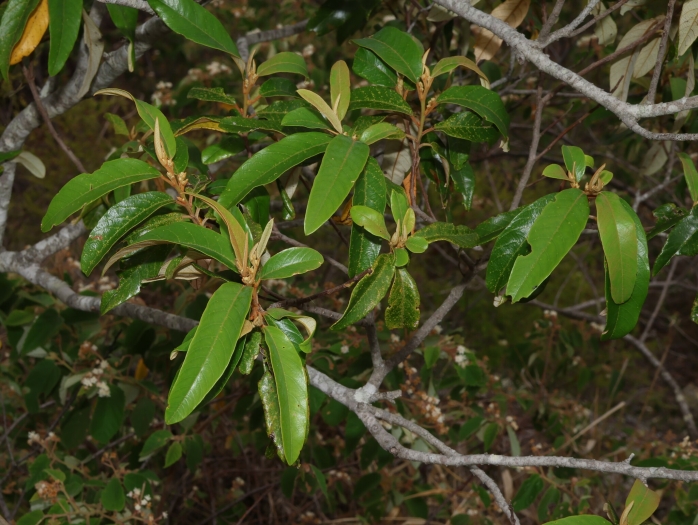Red Ash
(Alphitonia excelsa)
Red Ash (Alphitonia excelsa)
/
/

© Greg Tasney
CC BY-SA 4.0
Image By:
© Greg Tasney
Recorded By:
Copyright:
CC BY-SA 4.0
Copyright Notice:
Photo by: © Greg Tasney | License Type: CC BY-SA 4.0 | License URL: http://creativecommons.org/licenses/by-sa/4.0/ | Uploader: gregtasney | Publisher: iNaturalist |
























Estimated Native Range
Summary
Alphitonia excelsa, commonly known as Red Ash or Soap Tree, is a deciduous tree native to a variety of habitats in Australia, including dry rainforest margins, open eucalypt forests, and along watercourses. It typically grows to a height of 23 to 82 feet (7 to 25 meters) with a canopy spread of 16 to 33 feet (5 to 10 meters). The tree is characterized by its dark glossy green leaves that are silvery underneath, which turn a reddish color before falling. It produces small, inconspicuous greenish-white flowers in late autumn to early winter, followed by globular, dark fruit that are not particularly showy but are attractive to wildlife.
Red Ash is valued for its hardy nature and adaptability to a range of soil types, though it prefers sandy soils with good drainage. It is drought-tolerant once established, making it suitable for xeriscaping and urban environments where water conservation is a priority. The tree’s ability to fix nitrogen in the soil makes it an excellent choice for land rehabilitation and as a pioneer species in bush regeneration projects. In cultivation, it requires full sun to part shade and can be used as a shade tree or for screening purposes. The wood of Alphitonia excelsa is used in boat-building due to its strength and durability. Indigenous Australians traditionally used the leaves as a soap substitute, rubbing them in water to produce a lather.CC BY-SA 4.0
Red Ash is valued for its hardy nature and adaptability to a range of soil types, though it prefers sandy soils with good drainage. It is drought-tolerant once established, making it suitable for xeriscaping and urban environments where water conservation is a priority. The tree’s ability to fix nitrogen in the soil makes it an excellent choice for land rehabilitation and as a pioneer species in bush regeneration projects. In cultivation, it requires full sun to part shade and can be used as a shade tree or for screening purposes. The wood of Alphitonia excelsa is used in boat-building due to its strength and durability. Indigenous Australians traditionally used the leaves as a soap substitute, rubbing them in water to produce a lather.CC BY-SA 4.0
Plant Description
- Plant Type: Tree
- Height: 20-82 feet
- Width: 16-33 feet
- Growth Rate: Moderate
- Flower Color: White
- Flowering Season: Spring, Summer
- Leaf Retention: Evergreen
Growth Requirements
- Sun: Full Sun, Part Shade
- Water: Medium
- Drainage: Medium, Fast
Common Uses
Bee Garden, Bird Garden, Butterfly Garden, Drought Tolerant, Erosion Control, Hedges, Low Maintenance
Natural Habitat
Native to dry rainforest margins, open eucalypt forests, and along watercourses in Australia
Other Names
Common Names: Red Ash, Leather Jacket, Mountain-Ash, Pink-Almond, Red Tweedie, Soap Tree, Red-Almond
Scientific Names: , Alphitonia excelsa, Alphitonia excelsa, Alphitonia excelsa, Alphitonia excelsa var. acutifolia, Ceanothus excelsa, Colubrina excelsa,
GBIF Accepted Name: